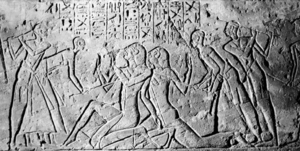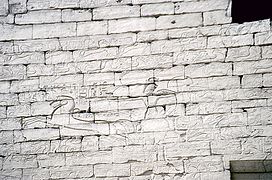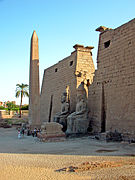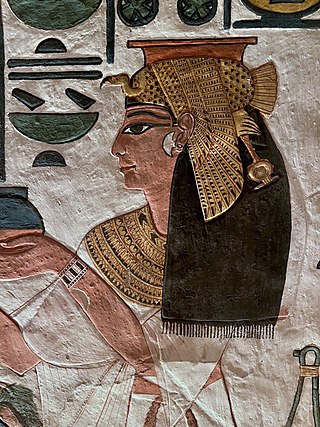
Nefertari, also known as Nefertari Meritmut, was an Egyptian queen and the first of the Great Royal Wives of Ramesses the Great. She is one of the best known Egyptian queens, among such women as Cleopatra, Nefertiti, and Hatshepsut, and one of the most prominent not known or thought to have reigned in her own right. She was highly educated and able to both read and write hieroglyphs, a very rare skill at the time. She used these skills in her diplomatic work, corresponding with other prominent royals of the time. Her lavishly decorated tomb, QV66, is one of the largest and most spectacular in the Valley of the Queens. Ramesses also constructed a temple for her at Abu Simbel next to his colossal monument there.
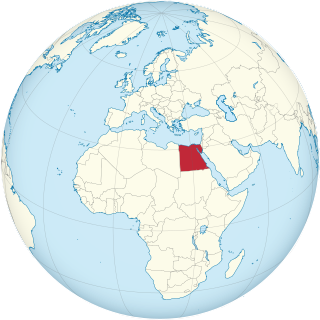
Articles related to Egypt include:

Menmaatre Seti I was the second pharaoh of the Nineteenth Dynasty of Egypt during the New Kingdom period, ruling c. 1294 or 1290 BC to 1279 BC. He was the son of Ramesses I and Sitre, and the father of Ramesses II.

The Sea Peoples were a group of tribes hypothesized to have attacked Egypt and other Eastern Mediterranean regions around 1200 BC during the Late Bronze Age. The hypothesis was first proposed by the 19th century Egyptologists Emmanuel de Rougé and Gaston Maspero, on the basis of primary sources such as the reliefs on the Mortuary Temple of Ramesses III at Medinet Habu. Subsequent research developed the hypothesis further, attempting to link these sources to other Late Bronze Age evidence of migration, piracy, and destruction. While initial versions of the hypothesis regarded the Sea Peoples as a primary cause of the Late Bronze Age collapse, more recent versions generally regard them as a symptom of events which were already in motion before their purported attacks.

Abu Simbel is a historic site comprising two massive rock-cut temples in the village of Abu Simbel, Aswan Governorate, Upper Egypt, near the border with Sudan. It is located on the western bank of Lake Nasser, about 230 km (140 mi) southwest of Aswan. The twin temples were originally carved out of the mountainside in the 13th century BC, during the 19th Dynasty reign of the Pharaoh Ramesses II. Their huge external rock relief figures of Ramesses II have become iconic. His wife, Nefertari, and children can be seen in smaller figures by his feet. Sculptures inside the Great Temple commemorate Ramesses II's heroic leadership at the Battle of Kadesh.

Menpehtyre Ramesses I was the founding pharaoh of ancient Egypt's 19th Dynasty. The dates for his short reign are not completely known but the timeline of late 1292–1290 BC is frequently cited as well as 1295–1294 BC. While Ramesses I was the founder of the 19th Dynasty, his brief reign mainly serves to mark the transition between the reign of Horemheb, who had stabilized Egypt in the late 18th Dynasty, and the rule of the powerful pharaohs of his own dynasty, in particular his son Seti I, and grandson Ramesses II.

The Battle of Kadesh took place in the 13th century BC between the Egyptian Empire led by pharaoh Ramesses II and the Hittite Empire led by king Muwatalli II. Their armies engaged each other at the Orontes River, just upstream of Lake Homs and near the archaeological site of Kadesh, along what is today the Lebanon–Syria border.

The Ramesseum is the memorial temple of Pharaoh Ramesses II. It is located in the Theban Necropolis in Upper Egypt, on the west of the River Nile, across from the modern city of Luxor. The name – or at least its French form Rhamesséion – was coined by Jean-François Champollion, who visited the ruins of the site in 1829 and first identified the hieroglyphs making up Ramesses's names and titles on the walls. It was originally called the House of millions of years of Usermaatra-setepenra that unites with Thebes-the-city in the domain of Amon.Usermaatra-setepenra was the prenomen of Ramesses II.

The New Kingdom, also referred to as the Egyptian Empire, was the ancient Egyptian state between the 16th century BC and the 11th century BC. This period of ancient Egyptian history covers the Eighteenth, Nineteenth, and Twentieth Dynasties. Through radiocarbon dating, the establishment of the New Kingdom has been placed between 1570 BC and 1544 BC. The New Kingdom followed the Second Intermediate Period and was succeeded by the Third Intermediate Period. It was the most prosperous time for the Egyptian people and marked the peak of Egypt's power.

Muwatalli II was a king of the New Kingdom of the Hittite empire c. 1295–1282 and 1295–1272 BC in the short chronology.

Medinet Habu is an archaeological locality situated near the foot of the Theban Hills on the West Bank of the River Nile opposite the modern city of Luxor, Egypt. Although other structures are located within the area and important discoveries have also been made at these sites, the location is today associated almost synonymously with the largest and best preserved site, the Mortuary Temple of Ramesses III.
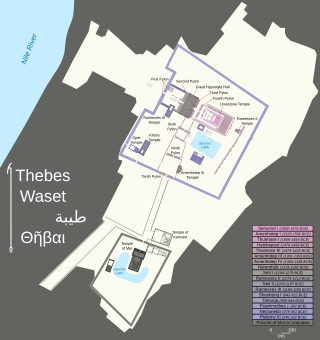
The Precinct of Amun-Re, located near Luxor, Egypt, is one of the four main temple enclosures that make up the immense Karnak Temple Complex. The precinct is by far the largest of these and the only one that is open to the general public. The temple complex is dedicated to the principal god of the Theban Triad, Amun, in the form of Amun-Re.

The Temple of Ramesses III at Medinet Habu was an important New Kingdom period temple structure in the West Bank of Luxor in Egypt. Aside from its size and architectural and artistic importance, the mortuary temple is probably best known as the source of inscribed reliefs depicting the advent and defeat of the Sea Peoples during the reign of Ramesses III, including the Battle of the Delta.
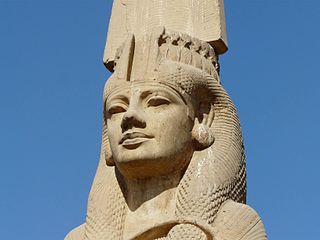
Meritamen was a daughter and later Great Royal Wife of Pharaoh Ramesses the Great.

Amun-her-khepeshef was the firstborn son of Pharaoh Ramesses II and Queen Nefertari.
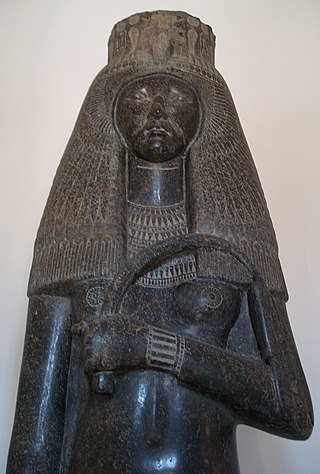
Tuya was the wife of Pharaoh Seti I of the Nineteenth Dynasty of Egypt and mother of Tia, Ramesses II, and possibly Henutmire.

Ramesses II, commonly known as Ramesses the Great, was an Egyptian pharaoh. He was the third ruler of the Nineteenth Dynasty. Along with Thutmose III of the Eighteenth Dynasty, he is often regarded as the greatest, most celebrated, and most powerful pharaoh of the New Kingdom, which itself was the most powerful period of ancient Egypt. He is also widely considered one of ancient Egypt's most successful warrior pharaohs, conducting no fewer than 15 military campaigns, all resulting in victories, excluding the Battle of Kadesh, generally considered a stalemate.
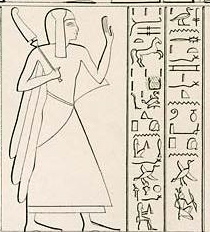
Pareherwenemef was an ancient Egyptian prince of the Nineteenth Dynasty of Egypt, the third son of Pharaoh Ramesses II, the second by Queen Nefertari.
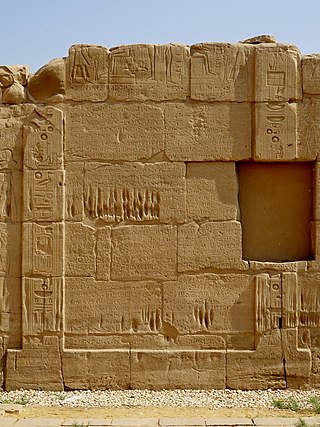
The Egyptian–Hittite peace treaty, also known as the Eternal Treaty or the Silver Treaty, is the only Ancient Near Eastern treaty for which the versions of both sides have survived. It is also the earliest known surviving peace treaty. It is sometimes called the Treaty of Kadesh, after the well-documented Battle of Kadesh that had been fought some sixteen years earlier, although Kadesh is not mentioned in the text. The treaty was concluded between Egyptian pharaoh Ramesses II and king of the Hittite empire Ḫattušili III in c. 1259 BC. Both sides of the treaty have been the subject of intensive scholarly study. The treaty itself did not bring about a peace; in fact, "an atmosphere of enmity between Hatti and Egypt lasted many years" until the eventual treaty of alliance was signed.
